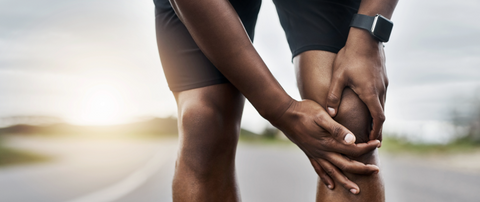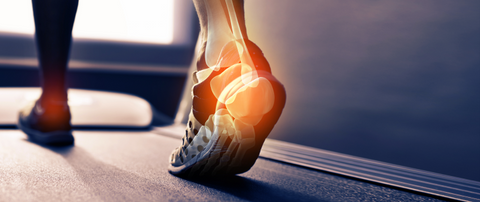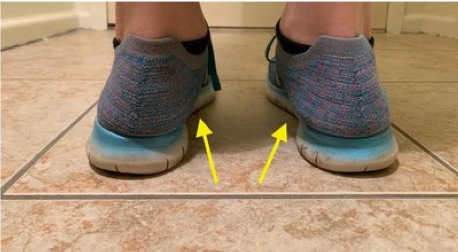Best 6 Ways to Reduce Pain From Plantar Fasciitis

Plantar fasciitis is a very common foot ailment that occurs when an inflammation of a thick band of tissue forms and connects the heel bone to the toes (Footwear News). It is usually self-diagnosable & self-treatable. The inflamed tissue runs across the bottom of the foot with the primary symptom being a stabbing pain near the heel. Plantar fasciitis happens a lot with runners and people who have flat feet, high arches, are overweight, or who are on their feet a lot.
With attentive care, the sufferer can often do these 6 things in their daily life to alleviate the pain caused by Plantar Fasciitis and help your foot heal faster (Podiatry Today).
-
Rest: Sure this one seems most obvious and easiest to implement, but as we know life often gets in the way of taking care of one’s self. General rest is critical when coping with Plantar Fasciitis and it is very important to keep weight off your foot until the inflammation goes down.
-
Ice: The old standby of ice to treat inflammation still works great , and there are multiple ways that you can implement this.
- A store bought ice pack always works great. They are relatively inexpensive and most efficient to use. One piece of advice would be to get one of minimal size as you want to focus on icing the heel area and not the entire bottom of the foot. General recommendation is to put it on your heel 3 to 4 times a day for 15 to 20 minutes at a time.
- Next option would be to make a homemade pack. First wrap a towel around a plastic bag filled with crushed ice or even around a package of frozen corn or peas. As with the store bought ice pack, put the homemade ice pack on your heel 3 to 4 times a day for 15 to 20 minutes at a time.
- Another option is to fill a shallow pan with water and ice and soak your heel in it for in it for 10 to 15 minutes a few times a day. Remember to keep your toes out of the water as we want to focus primarily on the heel area.
-
Pain relievers: Nonsteroidal anti-inflammatory drugs (NSAIDs) can make your foot feel better and help with inflammation. The most prominent NSAIDs are aspirin, ibuprofen, and naproxen, all available over the counter.
-
Stretching and exercise: Stretch your calves, Achilles tendon, and the bottom of your foot. Do exercises that make your lower leg and foot muscles stronger. This can help stabilize your ankle, ease pain, and keep plantar fasciitis from coming back.
-
Night splints: Most of us sleep with our feet pointed down, which shortens the plantar fascia and Achilles tendon. Night splints, which you wear while you sleep, keep your feet at a 90-degree angle. So instead of shortening your plantar fascia, you get a good, constant stretch while you sleep. Although night splints tend to be bulky, they work well and can help relieve pain while you sleep. Once the pain is gone, you can stop wearing them.
- Shoe inserts: For the daytime and your daily activities, quality shoe inserts are crucial to use. Most shoes are not factory produced with quality support for your feet. Also called insoles, arch supports, or orthotics, shoe inserts can give you extra cushion and added support that your shoes do not provide. You can get them over-the-counter (OTC) or have them custom made. Typically, your results will be just as good, and less expensive with OTC inserts, but quality is still important when considering. When you choose one, adjustability is key and it is important to make sure that you can achieve a level of firmness that is right for you -- and make sure it has good arch support. Also you should choose a pair of insoles with a good heel cup that provides extra cushion.
Can You Prevent Plantar Fasciitis?
Once your foot feels better, you can make a few lifestyle changes to help keep plantar fasciitis from coming back. These include:
-
Losing weight. Obviously there are numerous advantages to losing weight, but as it relates to plantar fasciitis, if you're overweight or obese, you may put more pressure on the bottom of your feet. That pressure can lead to plantar fasciitis.
- Make sure all of your footwear has good support. As important as it is to replace your athletic shoes often, it is equally important to make sure you replace your inserts when needed. Most inserts will last between 6-12 months, around the same lifetime of your athletic shoes. Ones you find the insert that works best for you, it is often helpful to buy additional pairs and have them in all of your shoes so you don’t have to move them from your works shoes, to your sneakers to your boots, etc.
- Stay away from high heels. Wearing them can cause your plantar fasciitis to come back
- Don’t go barefoot on hard surfaces. This includes your first few steps when you get up in the morning. It's common to feel plantar fasciitis then. So you'll want to keep some supportive footwear by your bed.
-
Do low-impact exercise. Activities like swimming or cycling won't cause plantar fasciitis or make it worse. After you're done, stretch out your calves and feet. For instance, curl and relax your toes and make circles with your feet and ankles.
-
Avoid high-impact activities. These include running and jumping, which put a lot of stress on your feet and can make your calf muscles tighter if you don't stretch them out.
- Keep doing your leg and foot stretches. Two of these include:
- Stretch your calves. Stand facing a wall. Put your hands on the wall. Step one foot behind the other, keeping both feet parallel to each other. Gently lean toward the wall, keeping your back heel on the ground. Hold for 10 seconds, and then switch feet. Repeat several times on each side.
- Stretch the bottom of your foot. Sit down and cross one foot over your other leg. Hold your toes and gently bend them backward.










